If you are an administrator of a business network, you probably know that Java could be the weakest link in your security.
On average, Java releases six updates per year. These updates are critical in stopping vulnerabilities from being exploited. But sometimes, the patching process can cause network bottlenecks or mission-critical applications to crash. This could happen due to many reasons including improper updating procedures. And that is why you need Java patch management tools.
Here is our list of the seven best Java patch management tools:
- SolarWinds Patch Manager – Java Patch Management EDITOR’S CHOICE This is an enterprise solution from one of the best network and server administration application makers; a powerful tool on its own, it can be combined with other SolarWinds products for even more comprehensive security coverage of a network and its clients. Start the 30-day free trial.
- Atera Patch Management Software Α remote monitoring and management tool that can also patch Java; offers a collection of community-developed scripts that can cover unique endpoints or hybrid requirements.
- ManageEngine Patch Manager Plus Α Java patching tool from another major maker of administration and monitoring tools; it covers a wide range of devices, offers customizable patches for unique deployments, and allows for different versions of Java to be run simultaneously on the same network.
- Syxsense Patch Management Α cloud-hosted enterprise IT and security management tool, that also comes with Java patching capabilities and would be an ideal solution for businesses that prefer cloud architecture and technology.
- Quest Patch Management Software Α software and hardware asset management tool with Java patching capabilities; features include scheduled scans, audit reports, and compliance level reporting for full control of a network.
- Ivanti Desktop and Server Management Α Java patching tool that comes with pre-tested patches for easier, more accurate deployments; it is considerate of resources and works without disrupting or even slowing down the end-user’s working day.
- NinjaRMM Τhis is a remote management and monitoring tool with Java updating features; it automatically spots vulnerabilities on devices regardless of whether they are in or out of the domain.
Java is a popular programming language and it is widely used.
It is this popularity that makes it such a big target. Apart from websites, Java is used in hardware, Android devices, the cloud, IoT, and many more technologies. This means that there is a higher exposure of weaknesses and vulnerabilities for hackers to take advantage of.
One of the best ways of fighting these attacks is with the help of regular patching. This is where we need to know about the seven best Java patch management tools.
What is a Patch Management Tool?
A patch management tool is a software package created to make the patch management process easier as well as more accurate. It automates the process of detecting vulnerabilities, identifying the critical patches, and applying them without affecting the business process as a whole. It is a critical system security tool.
What makes for a great Java Patch Management Tool?
Features to look for when choosing a Java patch management tool include:
- It should offer a range of supporting tools and features to help streamline the patching process.
- It should be easy to install, easy to use, and easy to configure – usually done by a single administrator with a few clicks.
- It should integrate well into the current network infrastructure – with the right roles and privileges assigned – and monitor as many varieties and flavors of operating systems as possible, as well as patching all the software solutions running on them and not just Java.
- It should have a light digital footprint and not hog resources – it should have as little an impact as possible on the performance of the other software and hardware running alongside it. It should also appear seamless, in the background, when it comes to the users at the endpoints.
- It should expand existing Microsoft and third-party patch management capabilities to provide a more comprehensive view of potential system vulnerabilities.
- It should have patch compliance reporting because, as with any IT management process involving compliance, it may be necessary to retain a paper trail of management history by generating security reports.
- It should have Wake on LAN (WoL) capability to work with devices that are asleep or shut down; it needs to be able to reactivate LANs whenever a patch deployment is scheduled.
OK; getting into the details, let have a look at the seven best Java patch management tools:
The best Java Patch Management tools
1. SolarWinds Patch Manager – Java Patch Management (FREE TRIAL)
SolarWinds Patch Manager is an IT security product that is used to patch enterprise applications and also has a dedicated Java Patch Management feature. Of course, with it being a product from the leading maker of server and network management tools, this too is one of their powerful, multifaceted administration tools.
Key features:
- Administrators can choose the specific patches they want to update.
- SolarWinds Patch Manager makes it easy to manage patches on virtual desktops and servers; it can organize virtual machines into groups and inventory virtual machines across the whole architecture.
- It has easy-to-use and powerful reporting options that show the status of patches and can show patch compliance to auditors.
- This tool can extend Microsoft patch management to include patches for Adobe, Firefox, and more – not just Java.
- The dashboard shows important patch data alongside other SolarWinds products that can also be easily integrated – administrators can see the latest available patches or top 10 missing patches, alongside a general health overview of the architecture, for example.
- It comes with pre-built and pretested packages to reduce errors and crashes and checks for failed patches with Package Boot technology – a utility that works alongside installer files to help ensure a proper pre-installation environment and reduce failed patches.
- An internal patch store – when a Java patch file is imported into Patch Manager, the installation file is verified, included in the package definition, and stored on the SolarWinds Patch Manager server for later use.
- It works perfectly with the Windows Update Agent – it can configure it using local policies, repair and re-install it using frequently used repair options, or force refresh Group Policy on machines, for example.
- Administrators can discover systems running versions of Java with known vulnerabilities and then use the package download assistant to get directions to the correct website where they can get the correct patch files; they can then control when and where updates are executed with advanced scheduling.
You can check out the 30-day fully functional free trial of SolarWinds Patch Manager.
2. Atera Patch Management Software
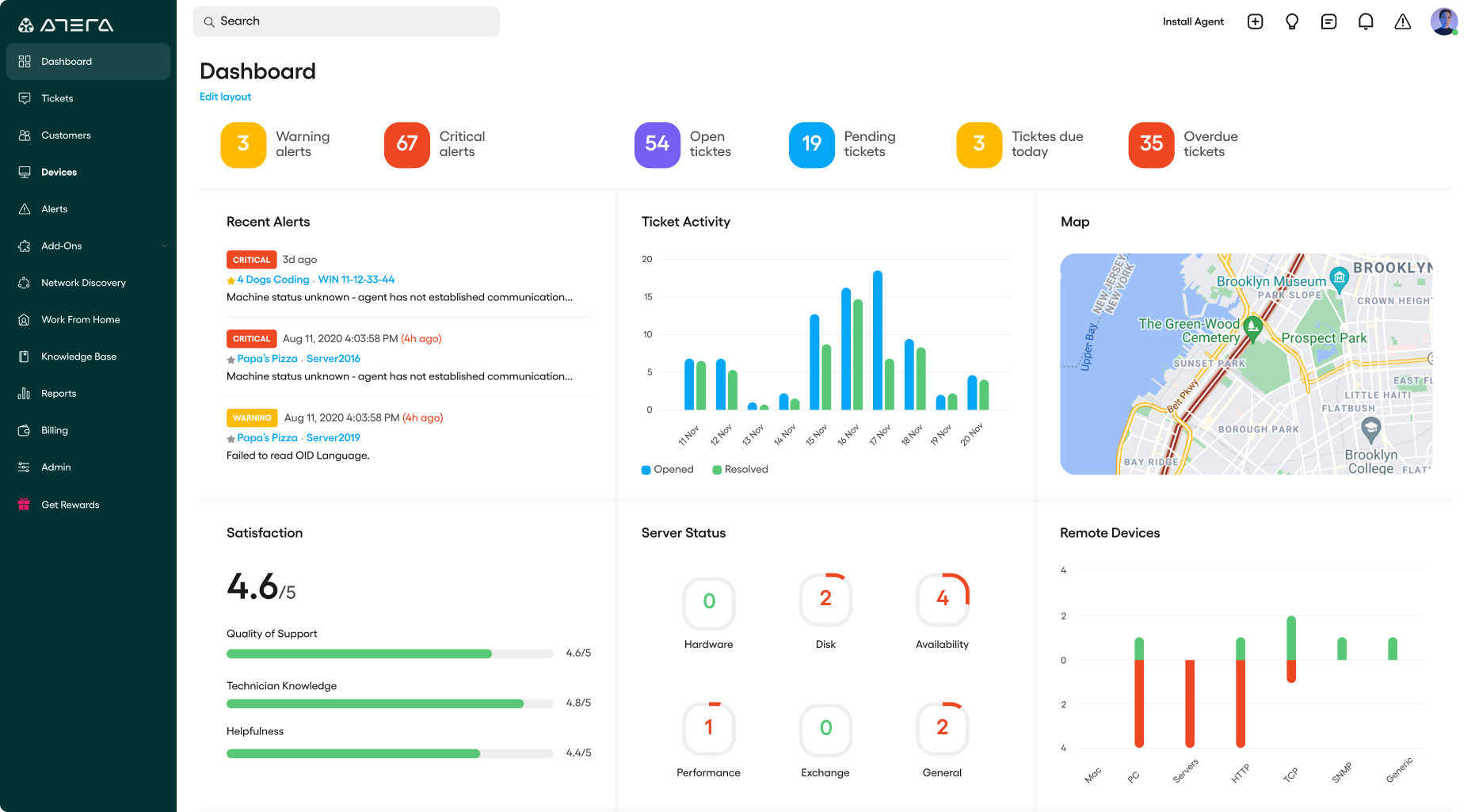
Atera Patch Management Software is part of its Remote Monitoring and Management solution that gives administrators full control over their patches from a centralized location. They can save time by automating patches for operating systems, applications, and hardware. They have a robust reporting tool to help them stay on top of every agent to ensure airtight security and control.
Of course, it can also install Java updates.
Key features:
- The Patch Status Summary gives a full overview of a patch management job; administrators get feedback on tasks that didn’t work, so they can handle them post-patching.
- Three reports are automatically generated from patch management activities that can also be shared.
- Atera Shared Script Library is a collection of hundreds of scripts – developed with the active participation of a supporting community – that can be cloned and added into automation profiles; they have all undergone quality tests and can be customized to meet every requirement – no matter how unique a patch management process may be.
- Report configuration includes an “exclude retired devices” option to leave out devices that are no longer in use – and filter data to only reflect the devices that are still online or working.
- Administrators can filter parameters to suit their needs, such as choosing the time frame, specific customers, automation profiles, or even tasks – they can even view a report for the output of all scripts that have been executed during a specific period.
- It can be used to plan on tasks for servers and workstations – like installing Java or Adobe updates – that handle crucial driver updates; administrators can configure their preferences for Microsoft updates with unique IT automation to meet the specific needs of each user.
- Apart from patching, the tool combines Remote Monitoring and Management (RMM) and Professional Services Automation (PSA), remote access, billing, and reporting – all on one platform; it can even be used for ticketing and customer satisfaction surveying.
Try Atera Patch Management Software FREE for 30 days.
3. ManageEngine Patch Manager Plus
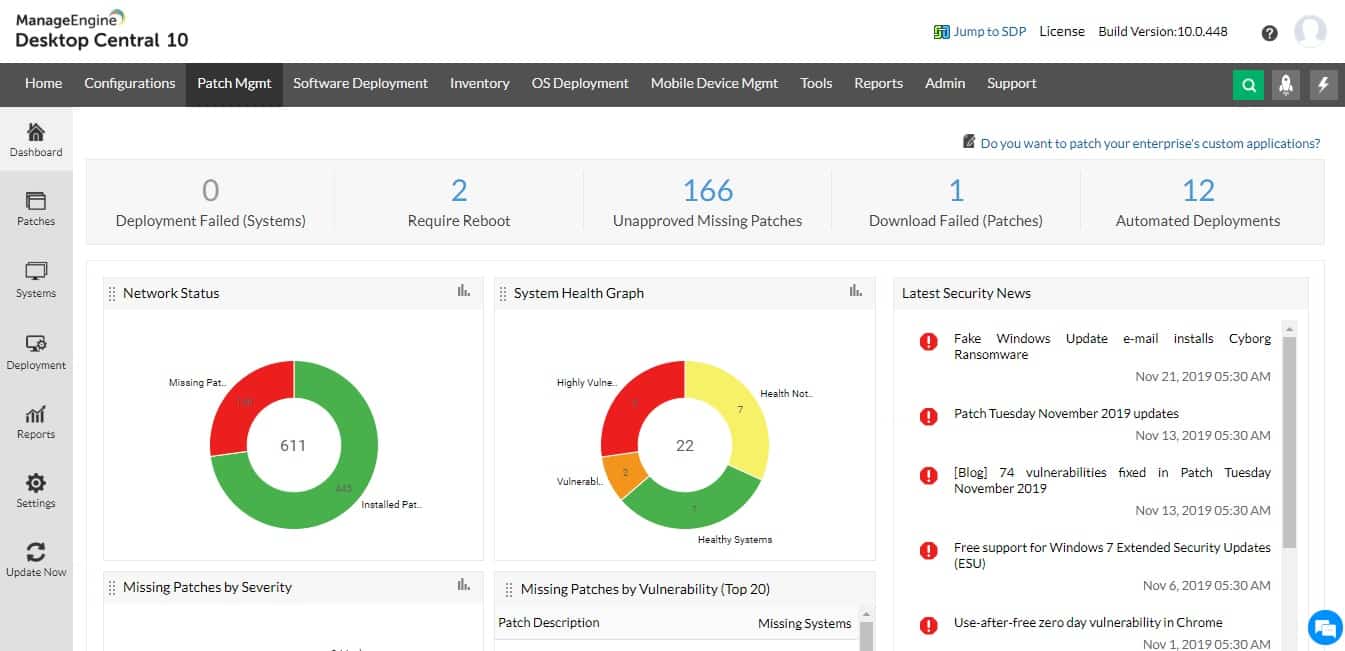
From ManageEngine we get Patch Manager Plus, an enterprise patching solution that works on Windows, macOS, and Linux endpoints. It offers patching support of over 650 third-party updates for over 350 third-party applications – including Java. This tool is available both as an on-premises or a cloud solution.
Key features:
- Endpoint scanning to detect missing patches, and then selecting and testing patches before deployment, to mitigate security risks.
- Administrators can automatically create test groups, try patches on them, and approve them for deployment to production environments.
- They can even customize patch deployment policies with ease to meet all unique business needs.
- The tool has insightful flexible, real-time audits and reports for a clearer picture of patch compliance and patch status of endpoints.
- But, more importantly, this tool comes with Java Manager which allows for multiple versions of Java to be run simultaneously on connected endpoints; older versions of the software can run parallel to the latest version without creating any conflicts.
- And then there is Patch Connect Plus, a feature that allows for Java updates in Microsoft Endpoint Configuration Manager (MECM) for more comprehensive coverage of endpoints.
Try ManageEngine Patch Manager Plus FREE for 30 days.
4. Syxsense Patch Management
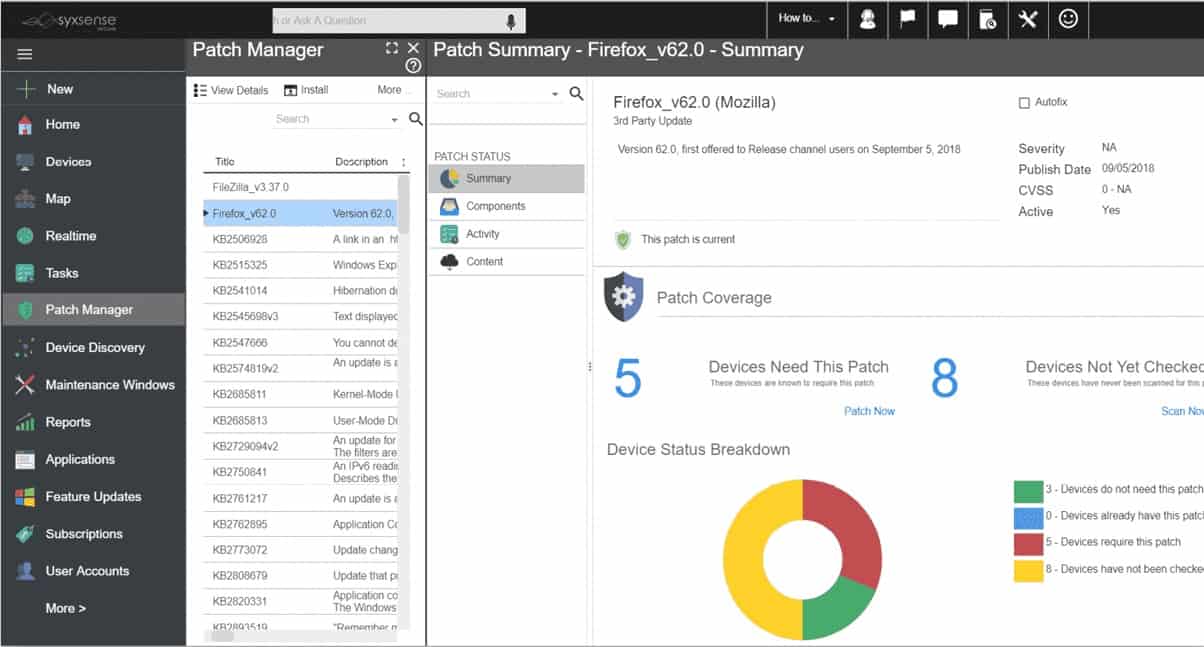
Syxsense is an enterprise tool for IT management and security monitoring, on top of patch management. It is cloud-hosted on Microsoft Azure making it remotely available from anywhere. What makes it even more versatile is the fact that it offers cross-platform support for all major operating systems – Windows, Mac, and Linux – be they connected or remote devices on the network.
Key features:
- This tool can automatically deploy the operating system and third-party patches and feature updates for all major operating systems running on endpoints; it can be used to patch Adobe, Java, Chrome, and many applications more.
- Administrators are always on top of their patching – they have a clear picture of vulnerabilities, their severity, and the patches that have been released to fix them.
- Depending on the level of exposure – if the vulnerabilities are currently exploitable, for example – administrators can see which devices pose critical risks and, therefore, need to be patched fast.
- The patching process can be planned depending on the times the endpoints are in use to minimize interference in the production environment; this plan can be integrated into a recurring schedule.
- All patching activities and statuses are displayed in insightful reports with flexible filtering and custom parameters.
Try Syxsense FREE for 14 days.
5. Quest Patch Management Software
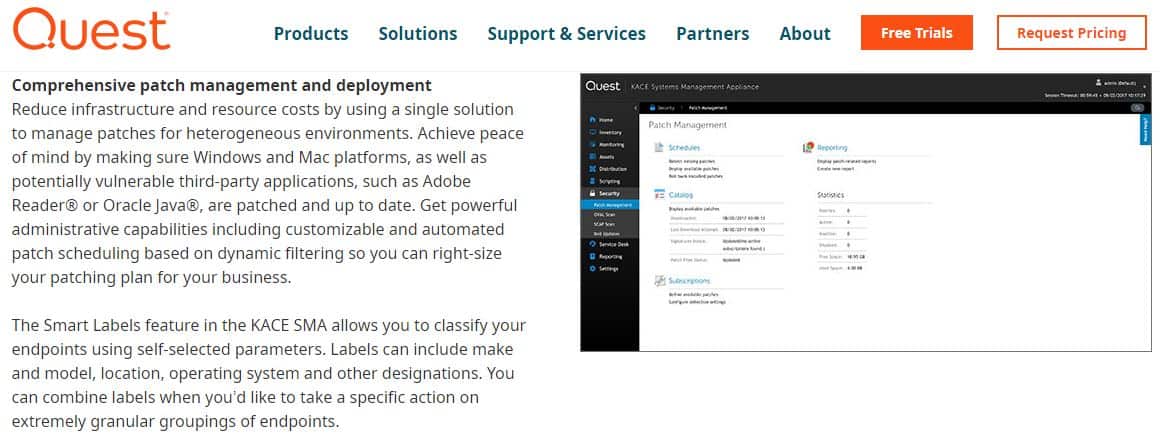
The Patch Management Software is a feature of the KACE Systems Management Appliance tool – Quest‘s comprehensive IT systems management for network-connected devices.
This comprehensive solution automates endpoint-related administrative tasks, inventory of hardware and software assets, as well as serving as a patch management solution for mission-critical applications and operating systems.
Key features:
- It offers patching and updating of both Windows and Mac platforms, as well as vulnerable third-party applications like Adobe Reader and Oracle Java.
- It runs periodic scans and patch assessments in real-time to identify endpoints where automated patching may have failed, so they can be quickly handled.
- Security audits also help to quickly spot vulnerabilities in endpoints and discover devices that aren’t compliant with security or configuration policies.
- Endpoints can be classified using custom parameters like make and model, location, or operating system; they can then be grouped when a broader, customized action needs to be taken on specific devices.
- Administrators can create and deploy pre-built or custom scripts to streamline configuration and security policies – like firewall, browser, and registry settings – that can target single devices, groups of them, or the entire network; desktop configurations can include management of antivirus packages.
- They can set deadlines that define when a patch is installed, while their users can choose when a reboot can be done to not interrupt their workday.
Try Quest KACE Systems Management Appliance FREE for 30 days.
6. Ivanti Desktop and Server Management
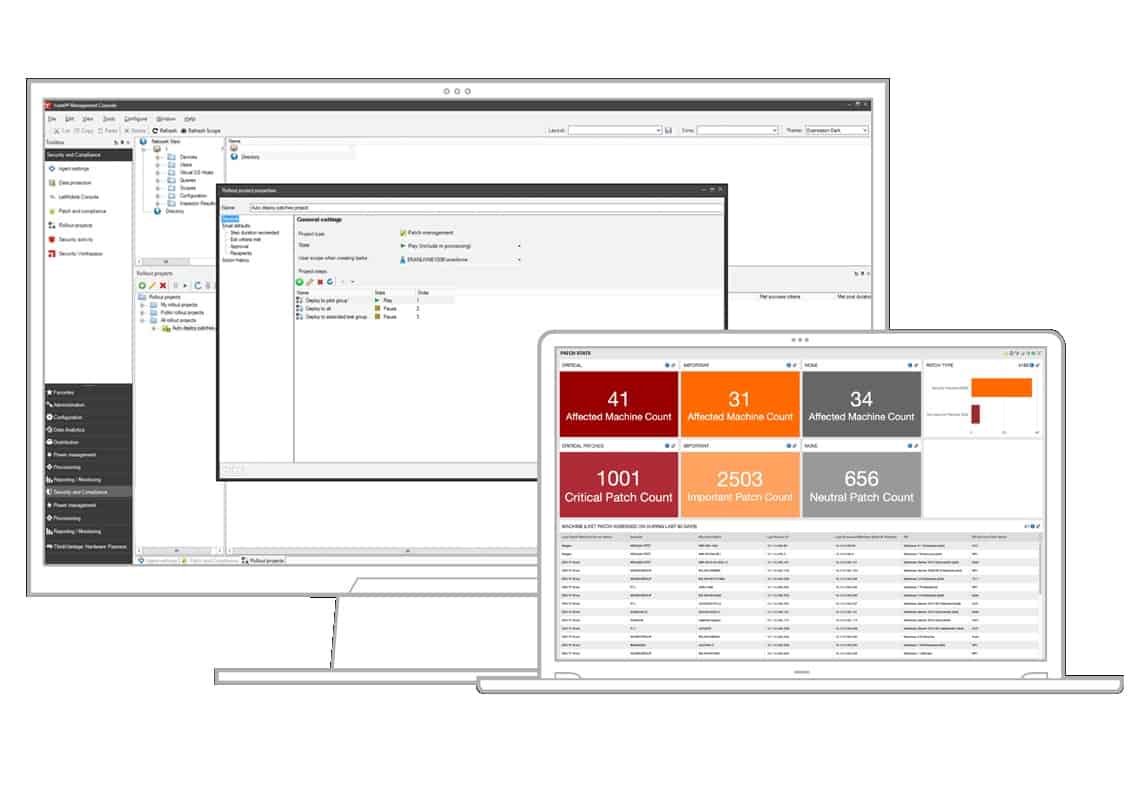
Although the Ivanti Desktop and Server Management solution is just that – a device and server management solution – it can be coupled with its Patch for Endpoint Manager to monitor patch compliance and systems management. Administrators can patch vulnerabilities of apps like Acrobat Flash, Internet browsers, as well as Java from a single dashboard.
Key features:
- It comes with accurate, pre-tested patches that have already been tested by in-house engineers.
- It can discover, inventory and patch both online and offline devices – including virtual machines; updated templates and snapshots can be used to patch devices before they even come back online.
- The tool has an extended catalog of patch vendors to address all devices and applications on a network – even on remote, mobile, and asleep devices.
- It has a light digital footprint that allows it to discover, assess, and patch client endpoints without slowing the network down.
- It can monitor vulnerabilities and deploy patches on applications running on all popular operating systems – Windows, macOS, and Linux.
- Administrators can test, package, and pre-cache patches across their network for quicker deployments and lesser impact on endpoint users.
Try Ivanti Desktop & Server Management for FREE.
7. NinjaRMM

NinjaRMM is the ultimate system administrator tool that allows them to work seamlessly with all devices on their network. Like the name suggests – the “RMM” is for Remote Management and Monitoring – the tool can drill down into individual devices and perform numerous administrative tasks including patch management to update Java and numerous other third-party software solutions.
Key features:
- NinjaRMM offers a complete patch management solution that makes it easy to patch all devices running Windows, Mac, or Linux – automatically, and from a single console.
- It automatically identifies and remediates vulnerabilities at speed and scale – with no infrastructure required; it covers endpoints that are both on and off the network to give real-time insight into patch compliance.
- The patching engine can take care of over 135 common applications – keeping them updated and secure at all times; it has software deployment, removal, and blacklisting to control what can and can’t be used on the network.
- It is a cloud-native patching solution that can reach devices anywhere – in or out of the domain and as long as they are online – with no need for complex, expensive patching servers to maintain.
- Administrators have complete control over the patching process; they can identify necessary patches, approve them, and schedule them according to their policies.
- They can get reports with insights into the health and performance of their endpoints at a glance, and they can deploy patches to vulnerable devices at a click of a button.
- These comprehensive reports can also be shared to allow other stakeholders to know about compliance rates.
Try NinjaRMM for FREE.
Why is patching important?
Ok, now that we have seen the seven best Java patch management tools, let’s have a look at why it is important to keep Java updated:
- To ensure security – patch management fixes vulnerabilities in software and applications that can be exploited.
- To improve system uptime – patch management ensures software and applications are up-to-date and running smoothly to achieve higher system uptimes.
- To achieve compliance – businesses and organizations need to meet compliances by regulatory bodies, and patch management is one way of doing so.
- To improve software features – software makers include bug fixes as well as feature and functionality updates for a better product and user experience (UX).
Why is it a challenge to keep Java patched?
Now, let’s have a look at why it is a challenge to keep Java – and even other software – updated:
- Reluctant users – many endpoint users find the task of updating it, or even clicking on the “OK” button of a Java Auto Update notification, to be an annoying or tedious task.
- Being unaware – and even when users are willing to undergo the updating process, they might not be aware of the risks they find themselves and the urgency in the need to immediately patch their vulnerable applications.
- Switching Java off – despite the important role it plays in a business computing environment, some users disable Java completely. When these un-patched versions come back online they can pose a critical threat.
- Machines that don’t support patching – in some cases, some machines can’t handle patching due to inability to process scripts, low memory, weak processors, or incompatible and outdated operating systems.
And, so, that is why administrators need to use one of the seven Java patch management tools we have just seen.
If there are any other tools you feel belong on this list or have any thoughts about the ones we have chosen, let us know.
L’article The 7 Best Java Patch Management Tools est apparu en premier sur Comparitech.

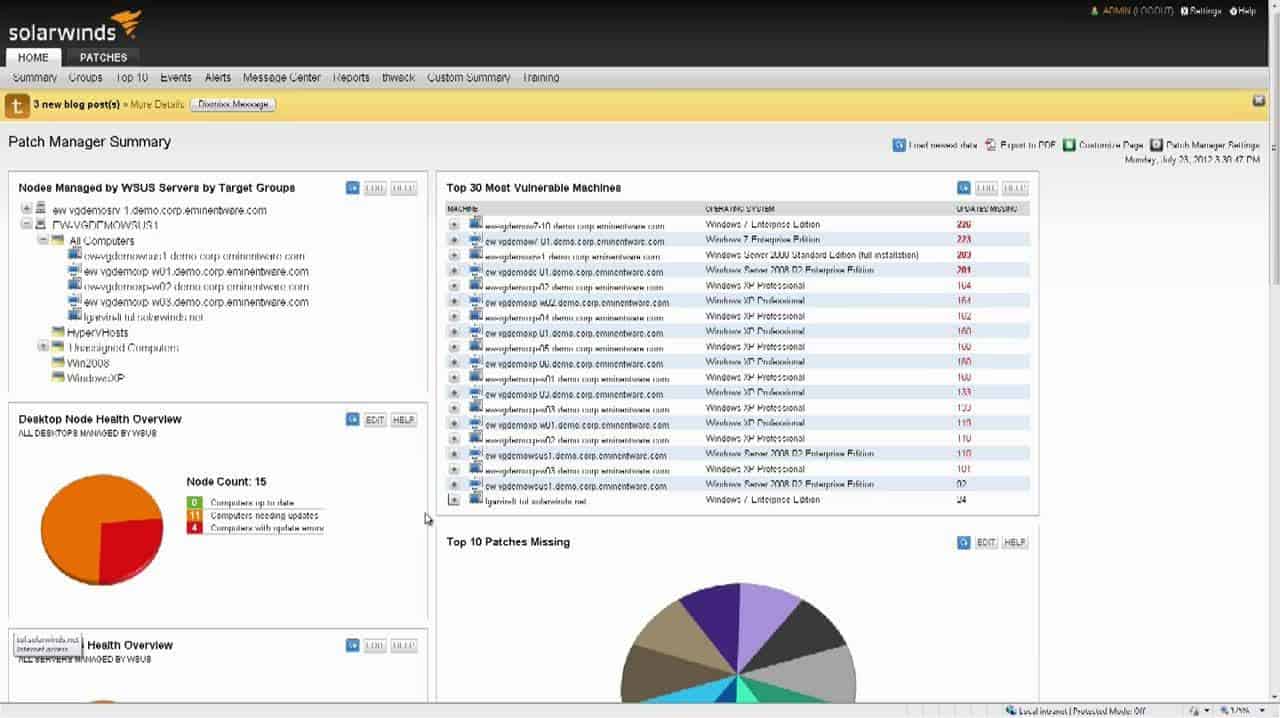
0 Commentaires